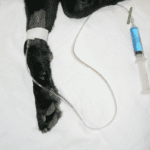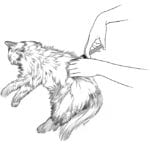Posts
When the desire to become a veterinarian first occurred to me, handing my career over to death-centered work was not on my radar. I was primarily interested in caring for…
Read MoreI recently attended the 15th annual International Association for Animal Hospice and Palliative Care (IAAHPC) conference in Louisville, Kentucky. It’s a gathering of veterinary professionals (DVM, technician, social worker, etc)…
Read MoreThe Companion Animal Euthanasia Training Academy (CAETA) invites you to consider the following fictional euthanasia case and reflect on how to proceed. After reviewing the case, read the questions and…
Read MoreThe euthanasia of a beloved pet is one of the most emotionally charged experiences a pet owner can face. While many families find comfort in a peaceful, compassionate process, others…
Read MoreCAETA is known for its advocacy of pre-euthanasia sleep for companion pets. It is part of our 14 essential components of companion animal euthanasia and the backbone of our ability…
Read MoreWhat is emotional blackmail and how does it apply to pet euthanasia and veterinary medicine? Emotional blackmail is a form of manipulation where a person uses fear, obligation, or guilt…
Read MoreLidocaine is a local anesthetic drug that can be administered to dogs and cats in high doses to achieve death. It requires pre-euthanasia anesthesia to induce unconsciousness beforehand and appears…
Read MoreThe Companion Animal Euthanasia Training Academy (CAETA) invites you to consider the following fictional euthanasia case and reflect on how to proceed. After reviewing the case, read the questions and…
Read MoreIt’s an unpleasant situation. A dog, cat, or other mammal has bitten a human. While some bites are more serious than others, if a person’s skin has been punctured to…
Read MoreRecently I was in conversation with some colleagues, discussing a veterinarian’s right to choose whether they proceed with a client’s euthanasia request for their pet. It got me wondering how…
Read MoreThe original title of this blog was going to be “The Importance of Keeping Families and Pets Together During Euthanasia.” However, I thought, pets are family, so it seemed redundant…
Read MoreIt’s that time of year to be reflective and rejuvenated. January 1st is one of my favorite dates because of all it holds; the past, present and future. This past…
Read MoreThe Companion Animal Euthanasia Training Academy (CAETA) invites you to consider the following fictional euthanasia case and reflect on how to proceed. After reviewing the case, read the questions and…
Read MoreEuthanasia appointments for animals center around the medical act to end life. The complete appointment layers in details that support the dying patient’s needs as well as loved ones. Euthanasias…
Read MoreDiscussing pet euthanasia with children has always been a challenge for veterinary professionals. It’s a bit unnerving to describe what’s about to take place to a young mind who may…
Read MoreI’m proud to be a nostalgic person who loves creating memories I can reminisce over. Reflecting on the life of my pets is a perfect example. Pets are woven into…
Read MoreLong have veterinarians tried to reduce active signs of death during pet euthanasia. A quiet death, with minimal to no movement from the pet’s body, is always preferred. Seeing a…
Read MoreThe Companion Animal Euthanasia Training Academy (CAETA) invites you to consider the following fictional euthanasia case and reflect on how to proceed. After reviewing the case, read the questions and…
Read MoreThis past weekend, I had the pleasure of partaking in the 8th annual Veterinary Social Work summit hosted by the IAVSW. This was not my first time attending this event,…
Read MoreWithout question, pet euthanasia is a final and irreversible procedure. The decisions leading up to it are taken seriously by both parties, veterinarian and pet owner. There has to be…
Read MoreHave you ever noticed how many times a day a veterinary professional says or writes, “Sorry”. When bringing this point to the forefront, many veterinary team members are surprised by…
Read MoreHelping pet patients with euthanasia as they reach the natural end of their life remains one of my greatest honors. Those of you out there doing the same know what…
Read MoreThe Companion Animal Euthanasia Training Academy (CAETA) invites you to consider the following fictional euthanasia case and reflect on how to proceed. After reviewing the case, read the questions and…
Read MoreEuthanizing companion animals is a familiar part of our culture, and it occurs at the veterinary hospital, the home, or the animal shelter. Animals deemed too sick or unable to…
Read MoreDeciding to euthanize a beloved family pet is hard work for most clients. It’s hard for them to know what’s best as their pet ages, succumbs to a disease, or…
Read MoreIt’s the season of graduation for thousands of newly-minted veterinarians. This blog is for you graduates as you prepare to care for dying patients. It can feel scary to navigate…
Read MoreCongratulations are in order! You have a new career achievement, becoming a Certified Peaceful Euthanasia Professional (CPEP). Offered especially for veterinary technicians, assistants, social workers, and practice managers, it means…
Read MoreThe Companion Animal Euthanasia Training Academy (CAETA) invites you to consider the following fictional euthanasia case and reflect on how to proceed. After reviewing the case, read the questions and…
Read MoreAs a receptionist or customer service representative (CSR), picking up the phone to discover a client is making their pet’s euthanasia appointment can be difficult. For one, you may be…
Read MoreIf you’ve spent enough time with me, you’ve likely heard about my first few euthanasia experiences, and how they weren’t my best. Compassionate yes, but technically challenging for me. My…
Read More“Endings Matter,” explains Dr. Kathleen Cooney. Veterinary patients, clients, and team members deserve to experience and deliver a peaceful euthanasia service each and every time. The veterinary team that takes…
Read MoreWith the recent trend of intraorgan euthanasia methods on the rise in animals as reported by the Companion Animal Euthanasia Training Academy (CAETA), I want to offer useful pointers on…
Read MoreThe Companion Animal Euthanasia Training Academy (CAETA) invites you to consider the following fictional euthanasia case and reflect on how to proceed. After reviewing the case, read the questions and…
Read MoreAs veterinary professionals, we are caregivers who shower love and compassion on others. With all you give to your clients, who is caring for you? It is within your control…
Read MoreEmotional Intelligence (EI) is a learned skill. Sure, some folks are born with a higher sense of self-awareness and the ability to perceive their surroundings, and social skills can be…
Read More“I’m Dr. Kathleen Cooney and I’m a Certified Peaceful Euthanasia Veterinarian.” This feels great to say and it’s been a long time coming. Over the years, many of you have…
Read More“Euthanasia is considered one of the most common procedures in veterinary medicine,” states Dr. Kathy Cooney, founder of the Companion Animal Euthanasia Training Academy (CAETA). You may be surprised to…
Read MoreFor many years, the Companion Animal Euthanasia Training Academy (CAETA), has taught the intracardiac euthanasia technique in one particular manner for companion animals. I’ll call it “the common way,” which…
Read MoreDo you feel there is an increase in pet euthanasia services over the holidays? If you do, you are not alone. I asked this question of Erin Bedell, one of…
Read MorePain has no place during euthanasia. By popular demand these days, pet patients are being given sedation medications to relax them into deep sleep before the administration of euthanasia solution,…
Read MoreBy Rebecca Rose, RVT As we kick off Veterinary Technician Appreciation Week today, we want to reflect on the ways that technicians and everyone on the team can support euthanasia…
Read MoreI’m buzzing with excitement after this year’s IAAHPC animal hospice conference. There were dynamic topics related to palliative medicine, hospice care, business, and of course, pet euthanasia. During one of…
Read MoreThis week, the Companion Animal Euthanasia Training Academy (CAETA) is adding more Instructors to our team. Over the past few months, growing our speaker bureau has been a priority, as…
Read MoreWritten by Rebecca Rose, RVT for CAETA When I asked a friend and colleague how they define “self-compassion,” they replied “being selfish.” I imagine several of you reading this feel…
Read MoreA quiet death is perceived as a better death. I’ve never heard it stated otherwise, whether human or animal. A quiet death denotes acceptance, one without struggle or resistance. And…
Read MoreHello friends, As you know, my work is always evolving. The Companion Animal Euthanasia Training Academy (CAETA) has grown steadily over the past 6 years and we’ve been honored to…
Read MoreWhen writing this blog, I tried to think of a way to put a pleasant spin on cleaning. Cleaning as a general rule is like licorice…either you love it or…
Read MoreIt’s 2023 and talking about death is still hard. Putting the topic of euthanasia front and center to clients, in parallel to other offerings like vaccinations or diagnostics, can feel…
Read MoreA recent 2022 study highlighted the euthanasia challenges veterinarians encounter outside of the companion animal space (think zoos, wildlife management, research). I found it particularly interesting reading about the types…
Read MoreThe warmer months bring a lovely opportunity to gather outside for companion animal euthanasia services, and this includes animals that already live outside like companion livestock. Owners appreciate the option…
Read MoreI’d like to begin this blog by acknowledging how important the drug pentobarbital sodium is as a euthanasia drug in veterinary medicine, shelter population management, and lab animal research. Here…
Read MoreI recently read an opinion article where the author complained about having to pay for the euthanasia of their dog. They claimed that since they had spent significant money at…
Read MoreThis week I helped a sweet cat named Charlie with what I refer to as age related changes plus kidney failure. Age related changes are those often seen in geriatric…
Read MoreAs a pet patient reaches the natural end of its life, clients face the difficult decision of continuing care or opting for euthanasia. They seek guidance for what’s best for…
Read MoreThere are some growing trends that are making the use of intravenous propofol less necessary during animal euthanasia. In companion animal medicine, it’s very common for veterinary staff to administer…
Read MoreFeeling nostalgic today, I tracked down the original digital copy of my in-home pet euthanasia book from 2011. In particular, chapter 10 on Starting a Euthanasia Service caught my eye. …
Read MoreFor the past 3 years, I’ve been recording my patients’ euthanasia appointments. It started out of as necessity to give myself protection should a client every voice concerns about my…
Read MoreToday is a special day for me. I’ve been accepted as a resident in the American College of Animal Welfare (ACAW). Yes! Since starting this journey back in 2020, my…
Read MoreCAETA is growing. After 5 years, we have reached an educational tipping point, when bringing on talented people is needed to meet the demand for companion animal euthanasia training events. …
Read MoreIt’s been 3 years since I euthanized my Daisy, a sweet old Jack Russell Terrier with a love for chasing bunnies and keeping a watchful eye on her family. As…
Read MoreWritten by Dr. Kris August. Shared by the Companion Animal Euthanasia Training Academy (CAETA) as a reminder for our readers about the importance of taking time in pet loss; to…
Read MoreEarlier this year, a member of the CAETA Euthanasia Facebook Group asked a very important question about behavioral euthanasia. In particular, they wanted to know what questions should be asked…
Read MoreI’ve often wondered what pet owners would do if euthanasia wasn’t a choice. We know that today, veterinary teams have the expertise and drugs to perform highly skilled euthanasia procedures,…
Read MoreThe average veterinary college offers students less than 4 hours of euthanasia training before graduation. As 2022, the Virginia-Maryland (VA-MD) College of Vet Med, part of Virginia Polytech University in…
Read More“My beloved dog has died. I wonder if I can do some good and donate his body for teaching.” This is what many pet owners ponder but aren’t sure how…
Read MoreAsk anyone who has experienced a difficult euthanasia (dysthanasia) with a beloved pet and they will tell you they never want to go through that again. For many, the emotions…
Read MoreIn early 2021, the Companion Animal Euthanasia Training Academy (CAETA) brought a short trivia presentation to a few veterinary conferences around the United States. It proved quite popular with veterinary…
Read MoreThanks to a recent pet owner survey, we can now say with certainty that a quality companion animal euthanasia is more than just the medical procedure itself. Owners want (and…
Read MoreRecently, it was brought to my attention the number of owner-requested euthanasias in animal shelters may be increasing. This is when humane euthanasia is provided for pets owned by members…
Read MoreThe Companion Animal Euthanasia Training Academy (CAETA) was pleased to recently learn that the American Veterinary Medical Association (AVMA) is going to host their 3rd symposium focused on the humane…
Read MoreDuring a podcast with Clinician’s Brief this week, I was asked if I had the power of time travel, would I go forward 100 years to see what veterinarians were…
Read MoreWritten by Thomas Landes In today’s blog we are taking a slightly different approach with an opportunity to highlight a poem written by a third-year veterinary student after learning with…
Read MoreIn support of part one, highlighting the importance of preplanning and good communication with members of the deaf community, this blog features information on how to choose the right drugs…
Read MoreRecently I was asked to aid in the passing of a sweet old dog owned by members of the deaf community. This family scheduled the appointment through my online web…
Read MoreI used to own a pet crematory as part of my end-of-life mobile veterinary service. Before this, I worked with local crematories in northern Colorado, all of whom did amazing work…
Read MoreFor many years, veterinarians and pet owners have reached out to me to talk about euthanasia experiences. They seek to understand if what they witnessed was normal, expected, unexpected or…
Read MoreI have always approached euthanasia decision-making as finding the path of least regret. Choosing euthanasia is hard. What REALLY prepares someone to elect euthanasia for a beloved friend? The physical…
Read MoreCompanion animals are likely to leave this world via one of two ways; naturally through the normal progression of physical decline or via euthanasia. Often pet owners make the choice…
Read MoreI’ve written before about how confusing controlled substance ordering and handling can be. It takes a village to sort through all the rules and regs to play the game correctly…
Read MoreSummer Brooks MS, RVT A few months ago, a member of the Companion Animal Euthanasia Discussion Group on Facebook asked what others do to honor the memory of their patients…
Read MoreThe American Animal Hospital Association (AAHA) is a leader in veterinary hospital standards. They are well known in the biz for their devotion to protecting the patient and client experience,…
Read MoreNot all body bags are created equal, and indeed there are numerous types out there. Those looking for quality prefer bags/containers that are durable, leak proof, and above all respectful…
Read MoreIt’s easy to take the “If it’s not broke, don’t fix it” approach to euthanasia work. Many practitioners feel comfortable with what they’ve been doing for years, and as long…
Read MoreWritten by Summer Brooks, MS, RVT. This blog article was inspired by a conversation on the Companion Animal Euthanasia Discussion Group Facebook page. A member posted: “I’ve had a few…
Read MoreGrief is such a hard thing. We live in a death-denying society. We hide away our emotions and are shamed into feeling we should be getting over the loss in…
Read MoreRecently I have fallen in love with the love hormone oxytocin. While learning ways to establish rapport and build trust with pet owners, this ‘moral molecule’ as it’s sometimes called…
Read MoreIf you take a moment to reflect on the most dangerous substances we inject into the body, you may come up with the same answer as I did. Chemotherapy. These…
Read MoreDave Shuey, MSW, RVT, CHPT. We all tell ourselves that euthanasia has the effect of ending suffering, both for the terminally ill or injured pet, as well as the owner…
Read MoreIf euthanasia becomes necessary to relieve suffering, it should be handled with respect and skill. The speed at which euthanasia solution is administered effects two main things; potential pain and…
Read MoreThe effects of stress on both animals and humans has been well documented, showing how stress can weaken the immune system, trigger the onset of cancer, increase inflammation, upset the…
Read MoreBy Lianna Titcombe, International Director for CAETA When I first became a veterinarian some 20 years ago, I suffered from crippling imposter syndrome. What fool had given me this DVM…
Read MoreGrieving pet owners benefit when they have access to pet loss support information. There are a variety of resources on the internet, however many of them are out of date…
Read MoreThis is a blog for veterinarians interested in starting house call or mobile practices incorporating in-home euthanasia (IHE), at-home euthanasia (AHE), or end-of-life (EOL) services. This includes 7 steps to help with the basics of licensing, legalities, business, as well as the practical, financial, & emotional aspects of starting or building a house call veterinary practice.
Read MoreA pet owner once asked me what the most important thing in my euthanasia comfort rooms was. Kleenex was my response. The floor could be dirt and the room cold;…
Read MoreWritten by Dr. Kari Trotsky with Peaceful Endings for Pets. Being a veterinarian, it may surprise you to know I’ve been on the receiving end of a family member and…
Read MoreWhile pentobarbital shortages are lessening in some parts of the world, many are still without and seeking safe and reliable alternatives. Pentobarbital is the #1 go-to drug for animal euthanasia…
Read MoreTo go beyond the basics, we’d best start with them so everyone is on the same page.For generations, the go-to plan at most vet hospitals has been the following…~ Pet…
Read MoreI’ll begin by saying I try to remove myself from politics whenever possible. There are inner powers at play that go beyond my comprehension, and when you know little of…
Read MorePentobarbital is almost back. Where has it been you ask? If you perform many euthanasias in your line of work, you know it’s been scarce for months, in the US…
Read MoreI’ll be the first to tell you I like my patients calm and peaceful before euthanasia. Who wouldn’t? Relaxed pets are safer to work with and this leads to a…
Read MoreWritten by Dr. Annie ForslundEdits by Dr. Kathleen Cooney Potbellied pigs are darling creatures loved by families around the world. They have full personalities to match their equally robust shape.…
Read MoreWritten and shared with permission by River Valley Gateway. With 67% of Americans owning some sort of pet, it’s no wonder that our furry friends play such a vital role…
Read MoreIn the coming days, a group of authors including myself are about to finally submit an academic paper on intrarenal euthanasia injections in cats. This study, first started in 2011,…
Read MoreTelehealth is a hot topic these days. COVID has opened our eyes to what’s possible in the modern tech era. Vet med has been utilizing telehealth since the invention of…
Read MoreSince the inception of the Companion Animal Euthanasia Training Academy in 2017, the Commitment to Excellence Seal has been offered to graduates of the 10-hour Master Certificate Program for use…
Read MoreWith the COVID pandemic continuing on, CAETA would like to take a moment to address a bit of the new normal around pet euthanasia during this unique time. In a…
Read MoreBy Dr. Amy Sugar: As veterinary professionals, we are privileged to provide our patients with one final service — ending their suffering through euthanasia. We also have the opportunity to…
Read MoreThe very first home euthanasia appointment I facilitated was a bit of a debacle. The dog’s name was Sage and she was an old, beautiful Golden Retriever. While she ultimately…
Read MoreBy Summer Brooks, RVT The dawning of a fresh New Year often motivates us to look around for new ways to be inspired. How can we add more value to…
Read More“If confusion is the first step to knowledge, I must be a genius.” ~ Larry Leisner To say controlled substance management is confusing is an understatement for most of us.…
Read MoreTrue or false: A good euthanasia is one that is skillfully performed and the desired death comes quickly. The answer is true, but there is often hidden context to questions…
Read MoreFor many of us, holiday celebrations include our pets. In my home, the dogs have stockings, leftovers are shared, and we will snuggle in to watch traditional holiday movie classics.…
Read MoreTalk with anyone who performs euthanasia regularly and they’ll tell you the number one comment they hear from clients is “Your job must be really hard” or “I couldn’t do…
Read MoreWe all know euthanasia is a necessary part of veterinary medicine. It is an ever present procedure to be called upon when suffering is assured and when the burden of…
Read MoreBy Stephanie DiTraglia, CAETA Administrative Assistant Like many of us who find ourselves within and among the veterinary industry, I’ve always known the animals’ world is where I wanted to…
Read MoreA Newer Meaning to a Relatively New Word I’m guessing that if you’ve been practicing veterinary medicine long enough, you’ve had the misfortune of witnessing a euthanasia gone wrong. You…
Read MoreOver the past two decades, I’ve built up a large library of useful phrases and sentiments to share with clients during euthanasia appointments. Knowing the exact time to offer them…
Read MoreCould our profession be utilizing highly skilled, empathetic veterinary technicians/nurses to perform companion animal euthanasia, rather than always relying on veterinarians? It turns out around 50% of US states already…
Read MoreAs the days warm, pet owners who’ve lost a pet tend to contemplate the option of home burial. There is no set figure on how many people choose backyard burial…
Read MoreThe following are suggested tips to reduce the risk of COVID-19 transmission during home euthanasia work. Note these have not been reviewed by health officials and you are encouraged to…
Read MoreEmotionally Intelligent Euthanasia A veterinary student recently shadowed me for a week to learn how I cope with the emotional strain of euthanasia-centric work. Her backstory was filled with highly…
Read MoreHave you ever gone to an educational conference and learned so much you didn’t know where to start? It’s easy to get overwhelmed with information and then struggle implementing it…
Read MoreWritten by David Shuey RVT, CHPT Lily was an elderly Arabian mare who lived with chronic laminitis in her later years. In recent weeks, her pain had become unmanageable. Her…
Read MoreA colleague told me recently how frustrated she was when a client verbally lashed out at her following a dysthanasia (bad death experience). The client was upset with the dog’s…
Read MoreThe intracardiac injection as a euthanasia technique in animals has been utilized since the early 20th century. The heart is a central vascular pump able to move euthanasia drugs effectively…
Read More



























































































































